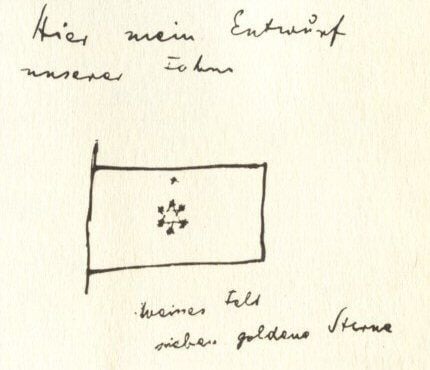“Do you know what the meaning of the Israeli flag is? …. It is white with two blue lines. The two lines represent two rivers, and in between is Israel. The rivers are the Nile and the Euphrates.”
Yasser Arafat,
Interview with Playboy, September 1988.
It may seem ridiculous, but across the Middle East, people widely give this claim credence. Israel, a country which has given away great swathes of land for peace, and sometimes not even for that, clearly has no desire to swell to the extent that it reaches two rivers many hundreds of miles apart.
So what is the real story behind the Israeli flag?
Join the fight for Israel’s fair coverage in the news
The Origins of the Flag of Israel
In reality, the Israeli flag was only adopted on 28th October 1948, five months after the establishment of the State of Israel. Such was the atmosphere at the time – a war was ongoing and there were more pressing tasks to attend to than the design of the flag of the newly-founded Israel.
On June 8th, 1948 Israel’s Provisional Government published a newspaper announcement to invite citizens to submit proposals for the nascent state’s emblem and flag. The announcement stipulated that the Israeli flag’s colors must be “light blue and white,” with “a Star of David or seven stars (in gold or some other color)” in the middle.
The contest attracted widespread attention, and the Emblem and Flag Committee received numerous suggestions from citizens from all sectors of the population. After going through the various entries, the committee drew up a shortlist of two proposals to be formally adopted as the official flag of Israel. Just over a month after announcing the competition, on July 11 1948, the government selected a design by the graphic artist Otto Wallisch, consisting of two blue stripes, and between them, a white stripe adorned with seven stars of David in “whitish gold (or yellow).”
That should have been that.
But it wasn’t.
Rather than accept the government’s proposal, the Provisional Council of State rejected it and proceeded to assemble a separate committee of its own to come up with the designs of both the emblem and flag of Israel.
After consulting representatives of Diaspora Jewish communities, the committee decided on July 28, 1948 to adopt the Zionist flag as the State of Israel’s official flag.
From The Zionist Flag to the Flag of Israel
Toward the end of the 19th century, numerous Jewish organizations adopted flags featuring the colors blue and white, together with six-sided stars, pairs of stripes, and other features such as words like Zion and Maccabee. The first such flag recorded was created by Israel Belkind, the founder of the Zionist Bilu movement, who escaped after a wave of pogroms and antisemitic laws in Czarist Russia. His variant is very similar to the contemporary design, with a blue Star of David featuring in the center, but unlike the single blue stripes along the top and bottom of the Israeli flag, his design had two above and two below the Star of David.
Related reading: Hatikvah: The Lyrics, Meaning and History of Israel’s National Anthem
Six years later, ahead of the First Zionist Congress in Basel, Switzerland, the Zionist Flag was created at the behest of David Wolfson, who served as Theodor Herzl‘s deputy. This version had the single stripes which appear on the Israeli flag, but had a number of differences – six small stars featured at each corner of the Star of David, with another star directly above it. Together, these stars were meant to recall the seven-hour work day Herzl wrote about in his publication “The Jewish State.” In addition, a lion featured in the middle of the Star of David.

The flag proposed by Herzl featured a clear Star of David, but he did not describe it in those terms. “Herewith my design for our flag. white field; seven golden stars.” Six of those stars are in formation in the center of the flag, forming together a larger star – the Star of David.
As the Zionist movement grew, so did the need for its own symbols and identity. Seeing that Herzl’s proposal was gaining little traction, David Wolffsohn (1856–1914), a Lithuanian businessman and second president of the Zionist Organization, wrote:
At the behest of our leader Herzl, I came to Basle to make preparations for the Zionist Congress. Among many other problems that occupied me then was one that contained something of the essence of the Jewish problem. What flag would we hang in the Congress Hall? Then an idea struck me. We have a flag—and it is blue and white. The talith (prayer shawl) with which we wrap ourselves when we pray: that is our symbol. Let us take this Talith from its bag and unroll it before the eyes of Israel and the eyes of all nations. So I ordered a blue and white flag with the Shield of David painted upon it. That is how the national flag, that flew over Congress Hall, came into being.
When the Congress was held, a very similar design was brought by Morris Harris, a member of New York Hovevei Zion, who made a banner with materials from his awning shop and the help of his mother. The flag was made with two blue stripes and a large blue Star of David in the center, all using the colors blue and white, and became known as the Flag of Zion. The design was accepted as the official Zionist flag at the Second Zionist Congress held in Switzerland in 1898, and it was this design that the committee referred to in July 1948 when the prototype Israeli flag was advanced.
Exactly three months after the committee’s decision, on October 28, the Provisional Council accepted the design. Henceforth, the Zionist flag has represented Israel as its national flag. The following year, in May 1949, the first Knesset passed the Flag and Emblem Law.
The Meaning of the Israeli Flag
A number of elements are common to a range of designs seen before the adoption of the flag of Israel in 1948: Words recalling the Jewish people’s heritage: a single star or a group of stars; the colors blue, white and gold; and horizontal stripes.
The elements set out by provisional government’s committee derived from the flag of the World Zionist Organization, which consisted of two light blue stripes with a Star of David set in between.
The Blue and White Stripes
While exactly which colors represented the Jewish people and Jewish kingdoms of millennia ago remain unknown, it is clear that the color known as techelet referred to in ancient sources was one of significance for the Jews.
Highly prized by ancient Mediterranean civilizations and mentioned 49 times in the Hebrew Bible, techelet was produced from a dye extracted from marine snails indigenous to the Mediterranean region. It was used in the clothing of the High Priest, the tapestries in the Tabernacle, and to color the tzitzit (tassles) affixed to the corners of four-cornered rectangular garments, known as tallit, traditionally worn by Jewish males over the age of thirteen.
Following the Roman destruction of the Second Temple in Jerusalem, the specifics regarding the source of the dye were lost, and for over 1,400 years thereafter, the vast majority of Jews have attached on plain white tassles to their prayer shawls, rather than use the wrong type of dye.
The majority opinion in mainstream Judaism considers the techelet referred to by various sources as being a variant of the colour blue, with shades from “midnight”, to “blue as the midday sky” mentioned. Although researchers believe that the real color is actually closer to Tyre Purple, a sky color blue came to be regarded as the closest approximation of the rare shade.
Join the fight for Israel’s fair coverage in the news
Regardless of the exact rendition of the prized techelet color, it is beyond dispute that by the year 1864, Jews would regularly sport white Tallit shawls with blue stripes, and it was from these garments that Jewish writer Ludwig August von Frankl of Bohemia took his cue when writing his paper “The Colors of the Land of Judah.” In it, von Frankl suggested that the Jewish people’s national colors should be sky blue and white:
…These are the colours of the beloved country, blue and white are the colours of Judah; White is the radiance of the priesthood, and blue, the splendours of the firmament.”
Approximately a century later, as Zionist and Jewish organizations started forming and creating symbols, emblems and flags with which to identify themselves, the colors blue and white were almost ubiquitous.
The Star of David
The six-pointed star known as the Star of David (or Shield of David) seen in the various prototypes was based on Theodor Herzl’s proposal that the Zionist flag be adorned with six or seven stars symbolizing seven daily hours of work.
Although named after David, there is no record of the star bearing any connection to the famous King David. Indeed, the six-pointed star now universally understood to represent the Jewish people only came to signify them much later. Originally, stars of various shapes were regarded by Jewish mystics as having special attributes which led to their being adopted as amulets and in religious art and literature, but were not used as a sign of Jewish identity.
Over the centuries, Jews came to be associated with pentagrams and hexagrams in various places across Europe. By the seventeenth century, the Star of David was seen flying from the main city synagogue in Prague in recognition of the Jewish effort in repelling invaders from the city. Around this time it was also being used in Budapest too, and over the following centuries its use spread all over Europe to decorate synagogues and religious objects. By the end of the nineteenth century, the Star of David regularly featured on the badges of Jewish organizations, unions, and even sports teams.
As a result of these historical processes, by the beginning of the twentieth century, both the Star of David and stripes of blue on a white background had become widely-accepted symbols of the Jewish people.
Whether or not one is religious, traditions and history are of importance in the national identity of all countries around the world. Israel is no different – and the tallit is a national symbol of the Jewish people. That, and no more than that, is the reason why the Israeli flag features parallel stripes.
Learned something new here? Please take a moment to share this article on social media and follow the Israel In Focus page on Facebook to read more articles explaining Israel’s history, politics, and international affairs. Click here to learn more!


